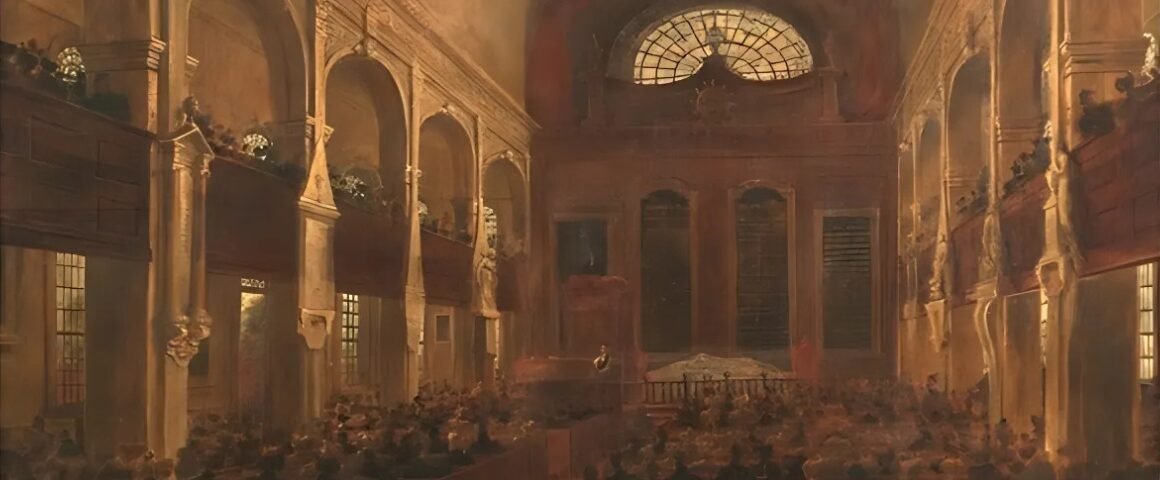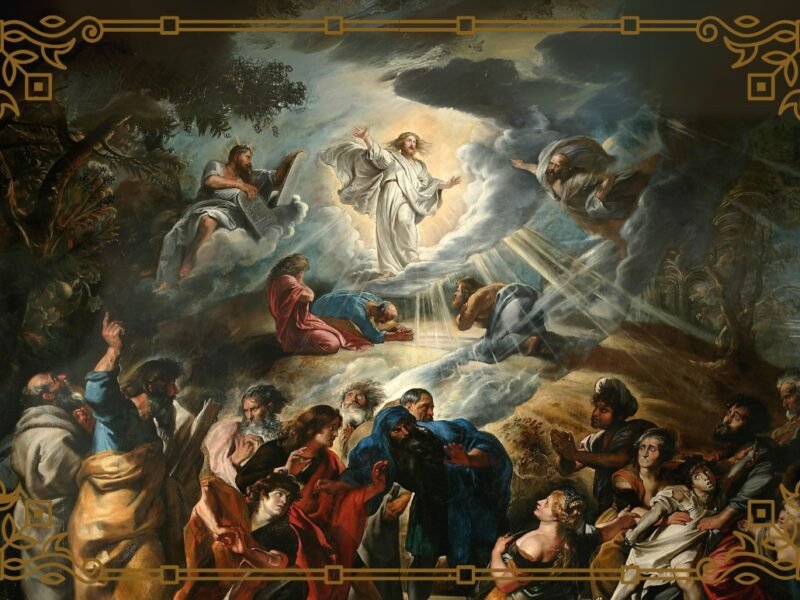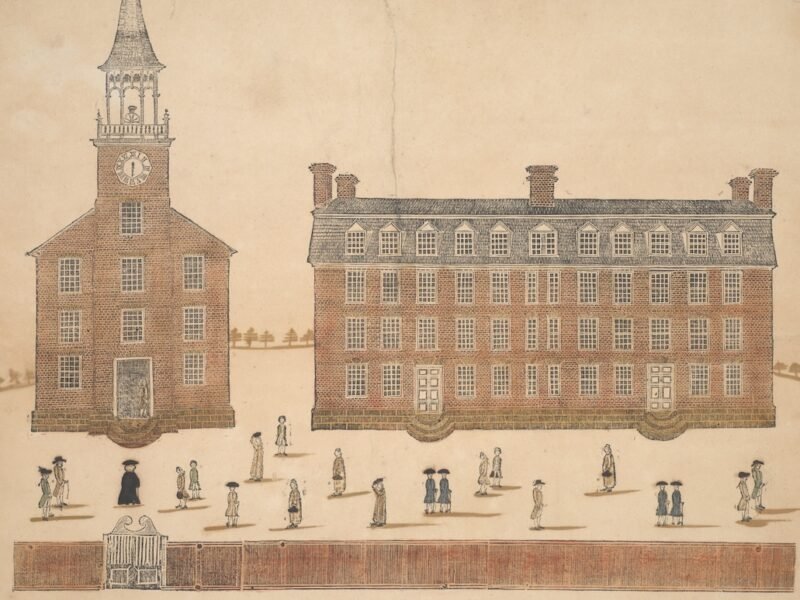Contemporary eucharistic liturgies tend to follow a standard “shape” – a ministry of the Word, culminating in the exchange of the Peace; next, a ministry of the Sacrament, based on the “four-fold shape” of liturgical action first proposed by Dom Gregory Dix: taking, giving thanks, breaking, and giving; and a eucharistic prayer that conforms to the “west Syrian” or “Antiochene” structure based on a Trinitarian economy of salvation. When recent prayer books make use of Cranmerian texts of the Prayer Books of 1552 to 1662 – as do both the 1979 Prayer Book of the Episcopal Church and the 2019 Prayer Book of the Anglican Church of North America – they squeeze them into this conventional liturgical shape, to a greater or lesser extent. What is ignored or simply missed, is that the Cranmerian texts have their own distinctive “shape”, one structured around the Pauline triad of repentance, faith and works (or “guilt, grace, and gratitude”), the moments of the soul’s response to the gospel. By the mid-sixteenth century, this triad was a commonplace of Protestant orthodoxy.[1] As J. I. Packer observed, it comprises the fundamental building block of Cranmer’s liturgy (though Packer himself preferred the terms “sin, grace, faith”).[2] Cranmer’s Order of the Lord’s Supper is constituted by three such triads in succession: a Ministry of the Word, a Ministry of the Sacrament, and a “bridge” section in between.
As Rowan Williams observed,[3] Cranmer does not lay out his ideas in the linear fashion of recent liturgies, but in a kind of spiral movement (such as is found also in St. John’s Gospel). The worshipper returns to ideas already touched on, but each time in a new way, so that the return to the idea not only reinforces it, but also builds on and develops it. Cranmer’s liturgy begins with the Lord’s Prayer and the Collect for Purity, anchoring worship in the illumination of the mind by the teaching of Christ and in the purifying of the will by the Holy Spirit. What the Word teaches, that the Father’s Name be hallowed, is what we ask the Spirit to accomplish – “that we may worthily magnify thy holy name.” “Man’s chief end is to glorify God and [in so doing] to enjoy him for ever.” So we begin the journey that will be completed in the Gloria in excelsis. This triadic spiral movement is one of ascent from earth to heaven, from the realm of outward and visible works to the realities known by faith alone. We begin from God, in Word and Spirit, that we may return and attain our end in God. As Cranmer remarks: “being like eagles in this life, we should fly up into heaven in our hearts, where that Lamb is resident at the right hand of his Father, which taketh away the sins of the world; by whose stripes we are made whole; by whose passion we are filled at his table; and whose blood we receiving out of his holy side, do live for ever….”[4]
First Triad – the Ministry of the Word
Guilt and Repentance. The ministry of the Word begins with the rehearsal of the Law. As the rubric directs, the people still kneeling shall, after every Commandment, ask God mercy for their transgression thereof for the time past, and grace to keep the same for the time to come. The penitent desire for forgiveness and moral renewal thus awakened by the Law finds further expression in the Collects that follow. In them, “[t]he Church approaches God in all that indigence and need that must be a part of her in this earthly pilgrimage,”[5] and learns to look with confident expectation to the greatness of the Father’s power to relieve this need, a confidence grounded upon sure trust in Christ as Mediator, who as Son and Lord “liveth and reigneth” with the Father “in the unity of the Holy Ghost, ever one God, world without end.”[6] Thus we are moved from the moment of guilt and repentance towards the next moment, of grace and faith.
Grace and Faith. With the Epistle, Gospel, Creed, and Sermon, the worshippers hear and receive in faith Christ’s word of grace, proclaimed in the apostolic Scriptures, confessed in the Creeds, explained and applied by the clergy. In the Word of God, rightly preached and received by the Church, is disclosed a basis for righteousness and life with God, grounded not in his own works, but in unmerited grace of God offered to faith by the person and work of Christ.
Gratitude and Good Works. In the Offertory, the ministry of the Word continues with the reading of sentences of scripture selected to move worshippers to the exercise of the good works in which faith is expressed – both good works in general, and in particular the giving of alms for the relief of the poor and oblations for the work of the clergy. In obedience to the scriptural warrant “by thy holy Apostles” (cf 1 Timothy 2:1), these alms and oblations, together with prayers “for all men,” are “offered unto thy divine Majesty.” These intercessions are introduced by a bidding to pray “for the whole state of Christ’s Church militant here in earth”: that is, for the earthly community of the faithful called into existence by the preaching of the gospel, whose members were enrolled in their baptism “manfully to fight under [Christ’s] banner against sin, the world, and the devil,” and are ordered by estate and calling to carry forward that mission. Here is not the ambiguity one finds in recent liturgies of intercession “for the church and the world,” a formulation at odds with the scriptural critique of “the world” as human society organized in opposition to God, and problematic in its suggestion of alternative or confused loyalties. The end of our intercessions is not the improvement of the world, but its return to God in Christ, and its worship of the Father in spirit and in truth.
Second Triad – Bridge
Up to this point, there has been no reference to the Sacrament, but now the Exhortations and Invitation summon us explicitly to preparation for it, in a new triad of repentance, faith, and works. What was outwardly proclaimed in the Liturgy of the Word is now inwardly expressed in the soul. Guilt and repentance is expressed in the General Confession; grace and faith in the Absolution and Comfortable Words; good works and gratitude by the Sursum Corda, Preface, and Sanctus. A small number of Christocentric prefaces for major feasts rehearses the major phases of his humiliation and exaltation. In this middle bridge section, the worshippers are delivered by the grace of absolution (“we have an advocate with the Father”) from the downward pulling earthly gravity of sin into the upward-lifting heavenly gravity of gratitude (“lift up your hearts”; “with angels and archangels, and all the company of heaven”) so that in the administration of the sacrament there may be through faith alone a real participation in his body and blood, and mutual indwelling of Christ with his Church. Though no Calvinist, Cranmer’s thought here is very close to the idea stated by Calvin: “as long as Christ remains outside us, and we are separated from him, all that he has suffered and done for the salvation of the human race remains useless and of no value for us. Therefore, to share with us what he has received from the Father, he had to become ours, and to dwell within us.” “All that he possesses is nothing to us until we grow into one body with him” (Institutes 3.1.1).
Third Triad – Ministry of the Sacrament
Guilt and repentance. Just as Isaiah reacted with penitence to the vision of God adored by angels singing “Holy, Holy, Holy”, so here after singing the Sanctus the congregation approaches the Lord’s Table with repentance. In the Prayer of Humble Access, they are taught to seek grace to eat Christ’s Flesh and drink his Blood for the sake of cleansing of body and soul from sin and (renewed) incorporation into Christ, as those have learned (in the Confession and Absolution) not to trust in their own righteousness, but in God’s manifold and great mercy.
Grace and Faith. In what came to be called in 1662 the Prayer of Consecration, their faith is directed to the Father’s “tender mercy” in giving his Son “to suffer death on the cross for our redemption”; to the Son’s once for all self-offering “for the sins of the whole world”; to prayer for real participation in Christ’s body and blood, and to Christ’s own words of institution. In 1552 and 1559 the Prayer of Consecration breaks off after Christ’s words over the cup, that we may respond without delay to the words of Christ in the obedience of faith, by receiving the elements.[7]
Gratitude and good works. After all have received the elements in faith, the Lord’s Prayer is recited again, which he deploys here as he does also in the Order of Baptism, as the beginning of our response to the sacramental action. It seems to be Cranmer’s customary way of marking a new beginning of worship in dependence on Christ’s teaching, in renewed and strengthened devotion to the Father’s glory and dependence on the Father’s grace. Next follows a choice of prayers, in complementary language of sacrifice and gratitude. In the “prayer of Oblation” we offer “our sacrifice of praise and thanksgiving,” which entails the offering of “ourselves, our souls and bodies, to be a reasonable, holy, and lively sacrifice.” In the “prayer of Thanksgiving” we acknowledge the particular benefits of which the sacrament has assured us – God’s favour, incorporation into Christ’s body, and inheritance of his kingdom – and we pray for grace to continue in this “holy fellowship” and to accomplish “all such good works as thou hast prepared for us to walk in,” in the fulfilment of his loving purpose for us.
Sacrifice, as Augustine noted, is the act which unites men to communion with God, and it is for this sound reason that the language of sacrifice (rather than victory or moral example) is pervasive in the ministry of the Sacrament (the Communion proper). The liturgical form of this ministry sharply distinguishes the sacrifice of Christ for sin, commemorated in the prayer before receiving the elements (the Prayer of Consecration); from the sacrifice of his Church, which is of praise and thanksgiving, set forth in the Prayers (of Thanksgiving and of Oblation) after receiving the elements.[8] Yet precisely on the basis of that sharp distinction, it is able to unite them without confusion, and in right relation. The 1552 form of delivery exhorted the receiver of the bread to “feed on [Christ] in thy heart by faith with thanksgiving,” and after the cup, to “be thankful,” for it is the effect of Christ’s sacrifice for our sins, received by faith, that we offer ourselves in his grateful service. That is why the relocation of the Gloria in Excelsis to this position at the conclusion of the ministry of the Sacrament is a master-stroke of liturgical craft. It gives satisfying expression to the overflowing of praise and thanksgiving in the eucharistic sacrifice, and it does so with the hymn of the angels, after receiving in the sacrament the grace which unites us with them in the presence of God.
Thus by its appropriation of Christ’s sacrifice in faith the Church is caught up into his own movement toward the Father. The entire shape of Cranmer’s liturgy is one of return to God: first, by the prayers for the going forth and return of the Word and Spirit; second, through the Church’s preaching of the word; third, through communion with God established by the sacrifice of his Son. Nothing is left behind in this return: the ascent from earth to heaven is the return of the whole man into God; and there the “heart in pilgrimage” attains its end. “Thou hast made us for thyself, O Lord, and our hearts are restless until they find their rest in thee.”[9] Accordingly the congregation is dismissed with a declaration of God’s peace, that peace whereby we are kept “in the knowledge and love of God.” It is all God, God’s knowing and loving the glory of his own infinite goodness through his Word and Spirit, through his Church, so that we may rest in him also, and know that peace which passeth all understanding.
There is a rationale to the classical liturgical forms of the Eucharist in the Anglican tradition. The historical context and doctrinal logic of the Eucharist will be the focus of the annual Anglican Way conference in Savannah this February, hosted by the Prayer Book Society at St. John’s Church. It is an opportunity to reflect on “These Holy Mysteries: what Anglicans think about the Eucharist,” with speakers that include Ashley Null, Torrance Kirby, Bishop Peter Robinson, Sam Fornecker, Drew Keane, Neil Robertson, and the author.
Notes
- Commenting on the similar structural triad of “guilt, grace, and gratitude” in the Heidelberg Catechism of 1562, Lyle D. Bierma traces it to Luther’s reading of the Epistle to the Romans, as mediated by Melanchthon’s own treatise, the Loci Communes Theologici of 1521, for which it supplied the overall structure. “By the mid-sixteenth century, the triad of law-gospel-good works or sin-faith-love had become so much a part of the common stock of Protestant theology that the threefold division of the [Heidelberg Catechism] cannot be traced with any certainty to a particular source of author.” (Lyle D. Bierma et al: An introduction to the Heidelberg Catechism: sources, history, and theology, 2005, p. 86). ↑
- See his introduction to The Work of Thomas Cranmer, ed. G. E. Duffield (1965) p. xxvi. ↑
- In his sermon on the 450th anniversary of Cranmer’s martyrdom, Tuesday 21 March 2006 given at the invitation of the Prayer Book Society, at St Mary the Virgin, Oxford. The full text may be found at: http://www.archbishopofcanterbury.org/353 ↑
- From the “Disputations at Oxford” in Writings and Disputations of Thomas Cranmer…relative to the Lord Supper, edited for the Parker Society by the Rev. John Edmund Cox, M. A. … [The Works of Thomas Cranmer. Volume 1] 1844, p. 398. ↑
- Jungmann, Joseph A. The Mass of the Roman Rite: its origins and development (1951) I, p. 378 ↑
- Though the long ending is absent in most of the 1662 Collects, it is evidently implied by the formulas employed in 1552 and 1559. ↑
- The word “Amen” was added in 1662. ↑
- See Cranmer, Works and Disputations, (Parker Society, 1844) Vol. 1, p. 346. ↑
- Augustine, Confessions 1.1 ↑






